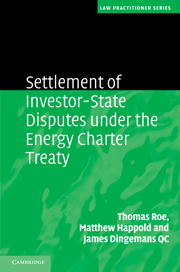Book contents
- Frontmatter
- Contents
- Foreword
- Preface
- Table of cases
- 1 Introduction
- 2 The applicable law
- 3 Availability of dispute settlement under Article 26
- 4 European Union law and the Energy Charter Treaty
- 5 Substantive law
- 6 Procedure
- 7 Contracting Parties' international responsibility for breaches of Part III of the ECT
- 8 Taxation
- Appendix A Selected provisions of the Energy Charter Treaty
- Appendix B Signatories to the Energy Charter Treaty
- Bibliography
- Index
4 - European Union law and the Energy Charter Treaty
Published online by Cambridge University Press: 05 July 2011
- Frontmatter
- Contents
- Foreword
- Preface
- Table of cases
- 1 Introduction
- 2 The applicable law
- 3 Availability of dispute settlement under Article 26
- 4 European Union law and the Energy Charter Treaty
- 5 Substantive law
- 6 Procedure
- 7 Contracting Parties' international responsibility for breaches of Part III of the ECT
- 8 Taxation
- Appendix A Selected provisions of the Energy Charter Treaty
- Appendix B Signatories to the Energy Charter Treaty
- Bibliography
- Index
Summary
Introduction
The European Union (as successor to the European Communities) and all of the EU member states are parties to the Energy Charter Treaty. From the EU law perspective, the ECT is a ‘mixed agreement’; that is, an agreement parts of which fall within the EU's competence and parts of which fall within the competences of the member states. In particular, at the time of its adoption foreign investment fell within the competences of the member states (although this has now changed, at least as regards foreign direct investment, which the Lisbon Treaty has brought within the Common Commercial Policy).
The fact that the ECT is a treaty to which the EU and its member states are parties distinguishes it from the numerous BITs entered into by individual member states. It has been argued (albeit, it is submitted, plainly wrongly) that intra-EU BITs (BITs entered into between two EU member states before either or both were EU member states) automatically terminate on both parties becoming EU members. However, given the ECT's status as a mixed agreement to which the EU is itself a party, participation in it cannot be per se incompatible with member states' obligations. Several member states' extra-EU BITs (BITs entered into between a member state and a non-member state) have been held to contain provisions which violate EU law on the ground that they have the potential to impede possible restrictions on capital movements (although this does not mean that the BITs are themselves invalid, only that the member states party to them are under an obligation to remove the incompatibilities).
- Type
- Chapter
- Information
- Publisher: Cambridge University PressPrint publication year: 2011
- 1
- Cited by



